China is one of the rare “popular” countries that require a *real* visa (not an *electronic* visa) for travelers from Canada and the USA. But traveling to China without a visa is possible with the simple tip to get around it — and it’s now even easier and more flexible thanks to a major loosening of their entry rules in December 2024.
China has a ton of attractions for absolutely every type of traveler. After all, it’s the 2nd most populous and 4th largest country in the world (and it’s actually bigger than Canada when we exclude the *water* area and consider just the *land* area, like the USA is too).
I loved my 3 trips to the country, including 1 that included 3 entries in one week in November 2024 (visa-free) and another one in March 2025 with the new loosened rules. But even when the country is amazing… real visas are always a bummer.
Here are the details on visa-free travel in China.
Basics of country entry requirements
I’m going to repeat it again because it’s astonishing how many travelers don’t know the most basic thing about traveling: you always need to check the entry requirements of the countries you want to go to.
It’s literally the ONLY mandatory step in all your trip planning.
The only one! Everything else is just details. You can always figure it out once you get there for everything, except this. Because if you don’t follow the entry rules, you’ll simply be denied boarding for your flight. The impact is dramatic, so this is vital.
Even the United Kingdom now requires an electronic visa (and 30+ European countries will too), so it’s more than time you learned that you need to check the rules if you want to travel. Always. For every country. For every trip. Simple.
You absolutely should read our ultimate guide to country entry requirements if you didn’t know that a passport is often invalid 6 months before its expiration date, that you sometimes need proof of exit from the country, that you sometimes need a specific number of empty pages in your passport, etc.
This is really the most basic thing if you want to be a traveler.
Basics of China’s entry requirements
To give you a little background, I’ll briefly summarize the outline of the rules for travel to China in recent years.
They have evolved in 3 stages:
- Real visa required (no other option)
- Visa-free travel allowed thanks to “transits”
- Visa-free transit rules loosened in December 2024
Real visa required (no other option)
Traveling to China technically requires a visa. A real visa, not an electronic one. By mail or in person (consulate/embassy), as if it were 2004. At least for many travelers, including Canadians, Americans, etc.
On my 1st visit to the country in 2017, it was logistically complex, and complying with their visa requirement was a very unpleasant step — as it almost always is when it’s not an electronic visa.
Visa-free travel allowed thanks to “transits”
Fortunately, visa-free travel to China has been possible for some years now, thanks to new visa-free transit rules. China also calls this a temporary entry permit.
It really improved the situation! They had 2 separate visa-free transit rules, for short transits (24 hours) or long transits (144 hours, or 72 hours in some regions). These rules were already generous enough to get around the requirement and visit the country quite easily.
It’s this visa-free transit rule that I just used at the end of November to enter China 3 times in one week to visit a bit during my epic round-the-world trip to get 1 million points.
I had just started writing the guide to these visa-free transit rules because the details were complex. And now I’ve had to start all over again because everything has changed already!
Visa-free transit rules loosened in December 2024
Visa-free travel to China is therefore now even easier!
On December 17, 2024, the government announced some loosening of these visa-free transit rules that make it even more simple and convenient: it’s now 240 hours and with fewer restrictions! This is a major move, even though it’s not like the complete elimination of visas that happened recently for certain nationalities.
It shows a clear trend: they want to encourage the rebound of tourism. Already before this change for visa-free transits, 17 of the 29 million travelers to China (59%) in 2024 traveled visa-free. Clearly, they want it to be even more.
Overview of the China visa-free travel rules
There are 2 separate rules that allow for visa-free travel to China:
- Long transits (240 hours)
- Short transits (24 hours)
The 1st rule is obviously the one that’s useful to really visit the country, and that’s the one that has just been improved and simplified. The 2nd rule is not very useful to visit and has not changed, but I’ll briefly cover it after this overview section.
Here are the essentials of China’s 240-hour visa-free transit rules:
- For citizens of 50+ countries
- Including Canada and the USA
- Allows you to stay in China for 10 days (240 hours)
- And even slightly more in practice
- Can be used several times (by leaving at a low price)
- So easy to stay 20 or even 30 days
- Available at 50+ airports nationwide
- Including all major airports
- Allows you to move around the vast majority of the country
- Full list of eligible regions below
- Involves arriving from country X and departing to country Y
- Not to/from the same country
- Taiwan, Hong Kong, and Macau are considered third countries
- So it’s very easy to comply with the rules
- Proof of exit required (can be a separate ticket)
- You can even exit by train (unlike entry)
- Extremely smooth and simple customs experience
- I entered 3 times and exited 3 times in 1 week
- A few changes compared to previous rules
- Interprovincial travel allowed
- Longer stay (240 hours instead of 144 or 72)
- More entry ports (60 instead of 39)
- More eligible regions (24 instead of 19)
- No change to other rules
- Your passport must be valid for 3 months, for example
I’ll go into more detail on each part below, but just to be very clear on the most important element, you can’t enter on a Canada-China ticket and exit on a China-Canada ticket. The country you exit to must be different from the country you enter from. That’s the key. That’s what makes it a “transit,” by definition.
In concrete terms, these days, the cheapest tickets from Canada to East Asia aren’t often to China anyway. It’s often to Hong Kong or Taiwan, for example. So you can fly from there to China (for as little as $107 one-way) and choose another nearby country for the exit, or the opposite. You can even exit China by train to Hong Kong for a few bucks if you like.
If you find that just 10 days isn’t enough, you can simply split your China trip into 2 stays of 10 days and insert a roundtrip to another country in between. This will give you 2o days easily. You have to exit to a different country than the one you entered from, but you can then enter without problem from the country you exited to the time before (it’s completely separate; as is almost always the case with country rules, the rules are relative to your entry).
Details of the China visa-free travel rules (240 hours)
Here’s more information on each element mentioned in the overview (for the 240-hour visa-free transit; the 24-hour transit is detailed in a separate section at the end).
Travelers eligible for China visa-free travel
Travelers from 54 countries are eligible for visa-free transit in China, including those from Canada, the USA, etc.
Here is the full list of eligible nationalities, by region.
| Region | Country |
|---|---|
| Europe (Schengen Area) | Austria |
| Europe (Schengen Area) | Belgium |
| Europe (Schengen Area) | Czechia |
| Europe (Schengen Area) | Denmark |
| Europe (Schengen Area) | Estonia |
| Europe (Schengen Area) | Finland |
| Europe (Schengen Area) | France |
| Europe (Schengen Area) | Germany |
| Europe (Schengen Area) | Greece |
| Europe (Schengen Area) | Hungary |
| Europe (Schengen Area) | Iceland |
| Europe (Schengen Area) | Italy |
| Europe (Schengen Area) | Latvia |
| Europe (Schengen Area) | Lithuania |
| Europe (Schengen Area) | Luxembourg |
| Europe (Schengen Area) | Malta |
| Europe (Schengen Area) | Netherlands |
| Europe (Schengen Area) | Norway |
| Europe (Schengen Area) | Poland |
| Europe (Schengen Area) | Portugal |
| Europe (Schengen Area) | Slovakia |
| Europe (Schengen Area) | Slovenia |
| Europe (Schengen Area) | Spain |
| Europe (Schengen Area) | Sweden |
| Europe (Schengen Area) | Switzerland |
| Europe (Schengen Area) | Bulgaria |
| Europe (Schengen Area) | Romania |
| Europe (Non-Schengen) | Russia |
| Europe (Non-Schengen) | United Kingdom |
| Europe (Non-Schengen) | Ireland |
| Europe (Non-Schengen) | Cyprus |
| Europe (Non-Schengen) | Ukraine |
| Europe (Non-Schengen) | Serbia |
| Europe (Non-Schengen) | Croatia |
| Europe (Non-Schengen) | Bosnia and Herzegovina |
| Europe (Non-Schengen) | Montenegro |
| Europe (Non-Schengen) | Macedonia |
| Europe (Non-Schengen) | Monaco |
| Europe (Non-Schengen) | Albania |
| Europe (Non-Schengen) | Belarus |
| Americas (North) | United States |
| Americas (North) | Canada |
| Americas (North) | Mexico |
| Americas (South) | Brazil |
| Americas (South) | Argentina |
| Americas (South) | Chile |
| Oceania | Australia |
| Oceania | New Zealand |
| Asia (East) | South Korea |
| Asia (East) | Japan |
| Asia (Southeast) | Singapore |
| Asia (Southeast) | Brunei Darussalam |
| Asia (Western) | United Arab Emirates |
| Asia (Western) | Qatar |
Length of visa-free stay in China
Technically, you’re entitled to a stay of 240 hours (10 days).
In practice, you can stay a bit longer. The countdown begins at midnight on the day after your arrival. In other words, the day of arrival doesn’t count.
Under the previous rules of 144 hours, I arrived in Guangzhou on November 23, but I had the right to stay in the country up to and including November 29 (so a bit more than the theoretical 144 hours).
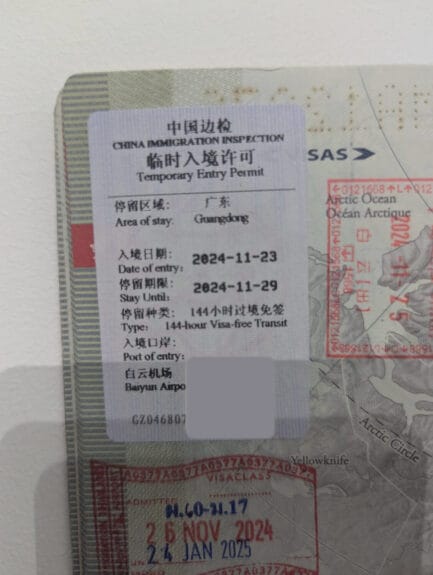
This gives you a little more time than the theoretical duration — almost a day more if you enter the country early in the morning and you leave late on the last day.
Maximum number of visa-free stays in China
There’s no maximum number of stays. Each individual entry obviously must follow the rules, but the number of entries aren’t limited.
For a 1st impression of China, 10 days in conjunction with another destination may be enough.
But if you find it’s not enough (you’re probably right; it’s a huge country), you can plan an exit to any other country — including Taiwan, Hong Kong, or Macau, which are the closest (and where you can exit without even taking an airplane). You don’t need to be out for long, you just need to be out! That said, I love those 3 destinations and recommend spending at least a bit of time.
Then you can go back to China for another 10 days. This gives you the equivalent of almost 3 weeks, so that’s starting to be pretty good. And if you want the equivalent of a full month (30 days), you can do it again.
It worked very well for me, even though I entered China 3 times over the course of a week, visa-free each time. It’s one of the only things I was a bit worried about on my round-the-world itinerary, but I had no problems (I was a bit more nervous than usual as I did not want to lose my million points 😂).
It’s not surprising that it worked: the rules don’t mention any maximum amount of stays. But I thought it was maybe more as part of the customs agent’s prerogative that it could be problematic if he found my itinerary weird.
I entered 2 times under the visa-free transit rules before my 1st visa-free transit had even expired. And my last 2 entries were from the country that was my exit country the time before (everything to make it look like I was trying to abuse the definition of “transit”).
I was prepared to explain to them the insanity of the 15 airlines I had to take to get 1 million points… but they didn’t even ask me a single question. None of the 3 times.
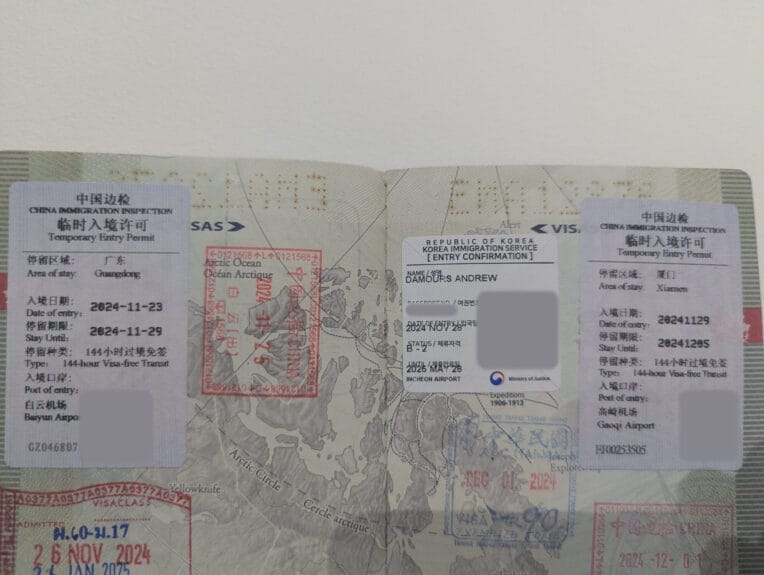
Ports of entry eligible for China visa-free travel
There are 60 eligible ports of entry, including all major airports and even a few seaports along with a train station.
All airports where the vast majority of travelers would want to arrive are included.
Here’s the full list of eligible ports of entry, by province (provinces include the entities that are considered province-equivalents by China, such as Beijing municipality).
| Region | Port of entry | ||
|---|---|---|---|
| Beijing | Beijing Capital International Airport (PEK) | ||
| Beijing | Beijing Daxing International Airport (PKX) | ||
| Tianjin | Tianjin Binhai International Airport (TSN) | ||
| Tianjin | Tianjin Seaport (Passenger) | ||
| Hebei | Shijiazhuang Zhengding International Airport (SJW) | ||
| Hebei | Qinhuangdao Seaport (Passenger) | ||
| Liaoning | Shenyang Taoxian International Airport (SHE) | ||
| Liaoning | Dalian Zhoushuizi International Airport (DLC) | ||
| Liaoning | Dalian Seaport (Passenger) | ||
| Shanghai | Shanghai Hongqiao International Airport (SHA) | ||
| Shanghai | Shanghai Pudong International Airport (PVG) | ||
| Shanghai | Shanghai Seaport (Passenger) | ||
| Jiangsu | Nanjing Lukou International Airport (NKG) | ||
| Jiangsu | Sunan Shuofang International Airport (WUX) | ||
| Jiangsu | Yangzhou Taizhou International Airport (YTY) | ||
| Jiangsu | Lianyungang Seaport (Passenger) | ||
| Zhejiang | Hangzhou Xiaoshan International Airport (HGH) | ||
| Zhejiang | Ningbo Lishe International Airport (NGB) | ||
| Zhejiang | Wenzhou Longwan International Airport (WNZ) | ||
| Zhejiang | Yiwu International Airport (YIW) | ||
| Zhejiang | Wenzhou Seaport (Passenger) | ||
| Zhejiang | Zhoushan Seaport (Passenger) | ||
| Anhui | Hefei Xinqiao International Airport (HFE) | ||
| Anhui | Huangshan Tunxi International Airport (TXN) | ||
| Fujian | Fuzhou Changle International Airport (FOC) | ||
| Fujian | Xiamen Gaoqi International Airport (XMN) | ||
| Fujian | Quanzhou Jinjiang International Airport (JJN) | ||
| Fujian | Wuyishan International Airport (WUS) | ||
| Fujian | Xiamen Seaport (Passenger) | ||
| Shandong | Jinan Yaoqiang International Airport (TNA) | ||
| Shandong | Qingdao Jiaodong International Airport (TAO) | ||
| Shandong | Yantai Penglai International Airport (YNT) | ||
| Shandong | Weihai Dashuibo International Airport (WEH) | ||
| Shandong | Qingdao Seaport (Passenger) | ||
| Henan | Zhengzhou Xinzheng International Airport (CGO) | ||
| Hubei | Wuhan Tianhe International Airport (WUH) | ||
| Hunan | Changsha Huanghua International Airport (CSX) | ||
| Hunan | Zhangjiajie Hehua International Airport (DYG) | ||
| Guangdong | Guangzhou Baiyun International Airport (CAN) | ||
| Guangdong | Shenzhen Bao’an International Airport (SZX) | ||
| Guangdong | Jieyang Chaoshan International Airport (SWA) | ||
| Guangdong | Nansha Seaport (Passenger) | ||
| Guangdong | Shekou Seaport (Passenger) | ||
| Hainan | Haikou Meilan International Airport (HAK) | ||
| Hainan | Sanya Phoenix International Airport (SYX) | ||
| Chongqing | Chongqing Jiangbei International Airport (CKG) | ||
| Guizhou | Guiyang Longdongbao International Airport (KWE) | ||
| Shaanxi | Xi’an Xianyang International Airport (XIY) | ||
| Shanxi | Taiyuan Wusu International Airport (TYN) | ||
| Heilongjiang | Harbin Taiping International Airport (HRB) | ||
| Jiangxi | Nanchang Changbei International Airport (KHN) | ||
| Guangxi | Nanning Wuxu International Airport (NNG) | ||
| Guangxi | Guilin Liangjiang International Airport (KWL) | ||
| Guangxi | Beihai Fucheng Airport (BHY) | ||
| Guangxi | Beihai Seaport (Passenger) | ||
| Sichuan | Chengdu Shuangliu International Airport (CTU) | ||
| Sichuan | Chengdu Tianfu International Airport (TFU) | ||
| Yunnan | Kunming Changshui International Airport (KMG) | ||
| Yunnan | Lijiang Sanyi International Airport (LJG) | ||
| Yunnan | Mohan Railway Port |
Geographical restrictions for China visa-free travel
Whereas the previous rules had the added complication of restricting you to staying in the province where you entered, the new rules have no such restriction.
You can cross provincial borders and travel anywhere that qualifies for visa-free transit — the eligible regions for the stay.
This means almost any place most travelers would want to go, but there are some exclusions (the Tibet Autonomous Region, for example, is not eligible). In the most popular destinations and in almost all provinces, the entire province is eligible. But in certain provinces, only select cities are eligible for the stay.
Here’s the full list of eligible regions, by province/province equivalent.
| Province/Province equivalent | Eligible region for stay |
|---|---|
| Beijing | Beijing |
| Tianjin | Tianjin |
| Hebei | Hebei Province |
| Liaoning | Liaoning Province |
| Shanghai | Shanghai |
| Jiangsu | Jiangsu Province |
| Zhejiang | Zhejiang Province |
| Anhui | Anhui Province |
| Fujian | Fujian Province |
| Shandong | Shandong Province |
| Henan | Henan Province |
| Hubei | Hubei Province |
| Hunan | Hunan Province |
| Guangdong | Guangdong Province |
| Hainan | Hainan Province |
| Chongqing | Chongqing |
| Guizhou | Guizhou Province |
| Shaanxi | Shaanxi Province |
| Shanxi | Taiyuan, Datong |
| Heilongjiang | Harbin |
| Jiangxi | Nanchang, Jingdezhen |
| Guangxi | Nanning, Liuzhou, Guilin, Wuzhou, Beihai, Fangchenggang, Qinzhou, Guigang, Yulin, Hezhou, Hechi, and Laibin |
| Sichuan | Chengdu, Zigong, Luzhou, Suining, Leshan, Deyang, Neijiang, Yibin, Ya’an, Meishan, and Ziyang |
| Yunnan | Kunming, Chuxiong, Yuxi, Honghe, Wenshan, Pu’er, Xishuangbanna, Dali, and Lijiang |
Transit definition for China visa-free travel
I’ve already detailed this part in the overview section, but it’s pretty straightforward.
You can’t exit to the country you entered from. Otherwise, it’s clearly not a transit and these rules are for transits.
For example, I did Vietnam-China-Thailand. I couldn’t have done Thailand-China-Thailand.
On the other hand, as mentioned, your 2nd entry can be from the country where you exited to after your 1st entry. I did Vietnam-China-Thailand and then Thailand-China-Korea and even Korea-China-Taiwan afterward. Each entry is considered separately because these are entry rules, as is (almost) always the case.
Classification of Greater China territories
If you’re not familiar with the term “Greater China”, we’ve already got a post explaining the peculiarities of Taiwan, Hong Kong, and Macau, all of which have their own entry rules separate from those of “mainland China.”
The good news is that all 3 are considered third countries for China’s visa-free transit purposes, so you can enter from or exit to these destinations. That makes things simple because they’re the closest destinations.
Also, if you want to avoid flying for your exit, you can go from China to Hong Kong by train or to Taiwan by ferry.
(Macau by train may seem like another option, but having gone to Macau during another trip to China, I know that, technically, the train stops in Zhuhai. It’s directly at the border, but on the Chinese side. I’m not sure if a ticket for this train would constitute proof of exit since Zhuhai isn’t in Macau proper. Even the buses to Macau don’t seem to cross the border. It’s simpler to just go to neighboring Hong Kong — the world’s longest bridge now links Hong Kong and Macau!)
Proof of exit required for China visa-free travel
Not all countries require proof of exit or onward travel. But in this case, since leaving within 10 days is what makes a visa-free “transit” stay possible, of course, proof of exit is required.
For less experienced travelers, I’ll specify that it’s the airline that will ask you for proof first when you check in or board your flight. As always. The Chinese customs officer will then ask for it again.
Here too, I had certain fears. Having traveled to many countries during the height of the pandemic’s insanity, I know very well that there are 2 very distinct concepts:
- The rules
- The interpretation/knowledge of the rules by airline employees
In my experience with visa-free travel to China, it went very well. The airline employees were aware of the visa-free transit rules (or, in the case of one of them, he didn’t seem to be… but he checked and go it very quickly).
China’s official website isn’t very well done in that it doesn’t explicitly say that the exit ticket can be a separate ticket from the entry ticket, but that’s probably just because it’s so obvious that it works. Especially since train exits are allowed, and it’s pretty much unavoidable that a train is on a separate ticket than the entry plane ticket.
In my case, 2 of my 3 transits were on separate tickets, and it’s definitely allowed.
As mentioned, while ports of entry are limited and listed, you can exit anywhere (in eligible areas of course). That’s what makes it possible to use a train or ferry ticket as proof of exit.
I’ve already mentioned Hong Kong, Taiwan, and maybe Macau. But there are also trains to Laos and ferries to South Korea and Japan. Trains to Vietnam and Russia are suspended and those to North Korea are probably of little interest to most travelers.
It fascinates me so much that so many people still needlessly print their plane ticket confirmation even to do their normal check-in (you absolutely never need to print that), so I specify that I didn’t print anything even for the proof of exit.
I showed this on my mobile phone and it was fine. It happens that some archaic countries ask for visas or documents to be printed, but it’ll be explicitly mentioned in the rules, and it’s rare — and China isn’t one of them (and NO airlines require you to have your booking printed, absolutely none: you can really stop printing that for nothing).
Customs experience for China visa-free travel
I have to honestly say that the process was much smoother and more efficient than I expected.
My chosen airports for optimizing my itinerary of 15 SkyTeam airlines are clearly not the most popular Chinese airports for travelers, so it can logically only be even better in the more touristy places like Beijing and Shanghai.
In November, my 3 entries/exits took place in Guangzhou (CAN), Xiamen (XMN), and Nanjing (NKG).
In all cases, in the arrivals area, there was clear signage for 144 or 24-hour visa-free transits (surely this will quickly be updated to reflect the 240 hours).
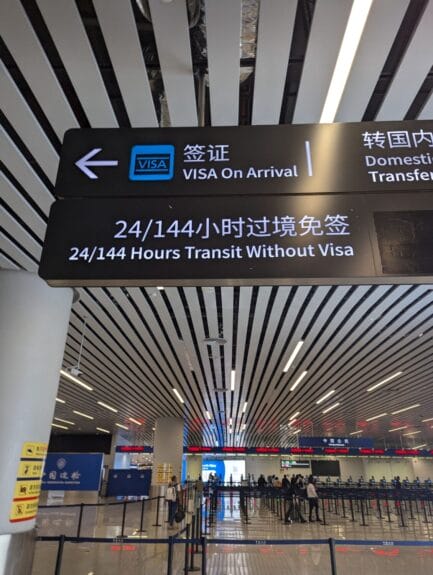
In the 2 instances when I was doing the long transit and was traveling on separate tickets, the signs led to a desk dedicated to what China calls the “temporary entry permit.”
In Guangzhou, the agent at this desk had me fill out the required form and gave me the entry permit that I then had to show to the agent in the regular immigration queue. In Xiamen, the agent at this desk gave me the form and sent me to the regular immigration queue and that agent gave me the entry permit.
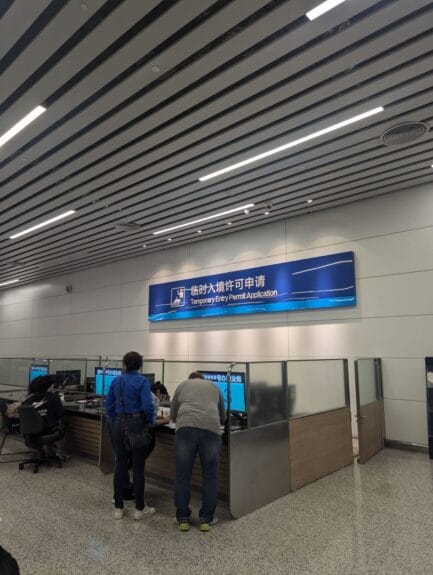
I don’t know why it’s not a standardized process, but in both cases, it was just as quick to get the permit, just in different places.
The special form to fill out is very short and simple. You need to keep the detachable “Departure” part and hand it in when you leave the country.
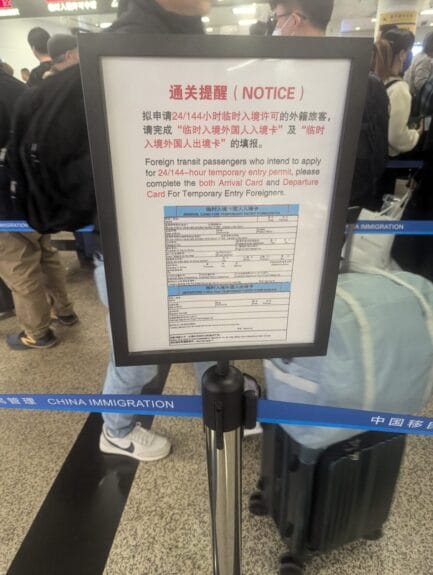
In Nanjing, it was a same-ticket connection, so I did the short transit. A China Eastern employee was waiting for me as I got off the airplane. I think it was the 1st time in my life that this had happened to me, despite having done literally hundreds of flights with connections.
I told her I wanted to enter the country and visit Nanjing (I’d given myself an 8-hour daytime connection), so she took me to a customs officer without having to queue, and he issued me the permit.
In all cases, the customs agents asked me for proof of my exit ticket, which I showed on my phone. I always have a portable charger — 1 of the 6 truly essential travel items — so I never have to worry about not having my documents.
In March 2025, I landed in Shenzhen (SXZ) and everything was just as simple.
Changes to China visa-free travel rules
For those who knew the previous rules, there are a few major differences since December 17, 2024.
The most interesting is that you can now move around the included regions (before you had to stay in the region you arrived in)!!!
The length of stay allowed has increased to 240 hours (before it was 144 hours or 72 hours).
Some airports and eligible regions have been added to the list, too. There are now 21 additional ports of entry (60 instead of 39) and 5 additional regions (24 instead of 19).
Other entry rules for trips to China
I won’t go into the other standard rules that you need to check, as for all countries, I just wanted to clearly explain visa-free transit, which is not well known.
For example, your passport must be valid for 3 months. That too, it’s crazy how many travelers don’t know this, but over a hundred countries (so over half the countries in the world) require either 3 or 6 months’ validity (including almost all of Europe).
For more details, I invite you once again to consult our ultimate guide to country entry rules.
Details of the China visa-free travel rules (24 hours)
As mentioned, there’s also a rule that allows you to transit in China visa-free for 24 hours.
You can use this to visit more briefly, and it’s obviously better than not visiting at all. But of course, it’s not as useful as the 240-hour visa-free transit to really explore China.
If you’re interested, the rules are very similar. I used it for my day trip to Nanjing.
This temporary entry permit can be for a bit more than the theoretical lengths too, because the whole day of your arrival doesn’t count.
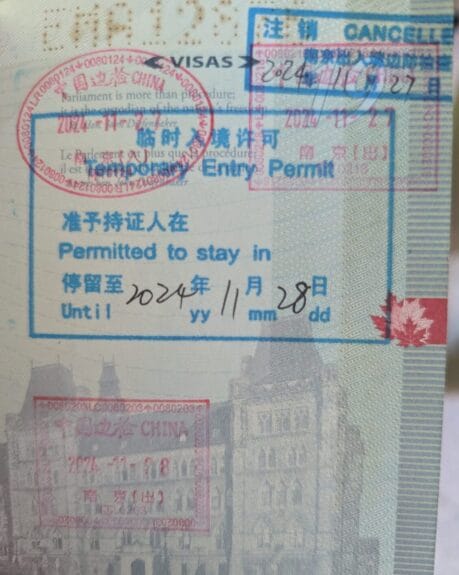
Learning how to travel for less
Join over 100,000 savvy Canadian travelers who already receive Flytrippers’ free newsletter so we can help you travel for less!






I spoke with the immigration helpline in Shanghai and they confirmed that it doesn’t matter if the 3rd country is your home country. So long as it’s different from the arriving country then all good.
Awesome, I agree with you. That other wording above was indeed confusing. Made me doubt too!
Hi Sebastian,
I was confused by reading on the Chinese Embassy pages if there js a restriction on the 3rd country being your country of citizenship for the 240 hour transit? For example as a Swedish citizen. Can I fly in HEL-PVG and then exit is PEK-ARN booked as separate tickets?
Many thanks for your advice.
Hi,
I believe it doesn’t matter, as long as the country you exit to is different from the one you entered from (and that you’re from an eligible country, of course; and Sweden works).
I can double-check though. Can you point me to where you saw something that might say otherwise?
All the times I used the visa-free transit, none of the flights were to/from my home country so I want to make sure.
Hi Andrew,
Really appreciate your reply. So confusing to me on this point. “Q4: If I come to a city in China that implements the 240-hour visa-free transit policy from a certain country (or region) and have a confirmed return ticket to my country (or region) within 240 hours, can I apply for this policy?
A: No. According to the regulations, the 240-hour visa-free transit policy is for foreigners transiting to a third country or region. Therefore, the departure and destination countries must be different.”
https://www.china-briefing.com/news/china-resumes-144-hour-visa-free-transit-policy-for-foreigners-who-can-apply/
Best regards.
Does your layover have any bearing on what your exit country will be? Ideally for me it would look something like: SFO-HKG-CKG on the way there and then leaving to HKG with a separate ticket home. Would it look like I came from Hong Kong to them?
Hi Sebastian,
The layover is all that matters. That’s just how flights work. Once in Hong Kong, people arriving from various other countries will all board the flight from HKG to CKG and the destination country can’t know where you’re all coming from originally, nor do they really care. You are arriving from Hong Kong, that’s it.
So you couldn’t fly back to Hong Kong directly, because you have to leave to a different country than the one you are arriving from. It’s really the only rule, that’s what makes it a transit by definition. If you go back to the country you entered from, China was your destination and not a transit.
You could however fly from Chongqing to Macao (just $112 most days) and then simply take the ferry or bus from Macao to Hong Kong. I loved that ferry ride, but now that the world’s longest bridge has opened, I’d probably choose that option for the novelty of it.
By the way, why are you going to Chongqing? I’m headed there in 2 days and it’s quite rare to see North Americans interested in visiting this city haha!